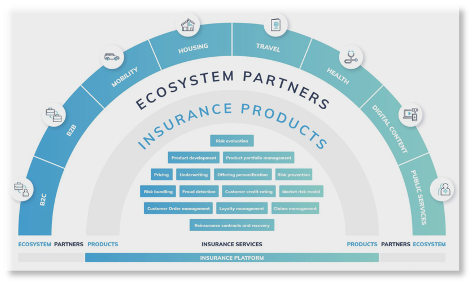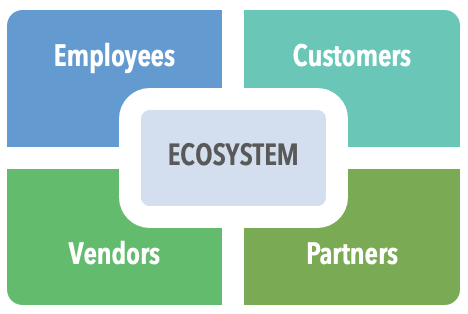Platforms and ecosystems are key in a digital economy and essential for innovation, scale, flexibility, customer experience and stickiness, not only to customers but to all ecosystem participants.

There are several types of platforms to consider when developing an appropriate strategy, each with its own characteristics and benefits, for example, marketplaces are very common, bringing buyers and sellers together. Technology platforms provide infrastructure and solutions that must be transparent for the end-user and for which a superior customer experience supersedes product-centricity.
These platforms are built for handling scale, adhering to 24/7–99.999% availability. Building such platforms requires all processes, across departments, to be well designed and integrated into the layered structure of the platform’s architecture.
This layered architecture enables the front-end to consume back-end services of various sources through an integration layer, regardless of their channel (physical store, online shop, mobile, counter, IoT, etc). Integration is not seldom the Achilles’ heel when designing and operating such platforms in which new services can easily be plugged-in.

Practically, this entails the following steps:
- Modularity of technical platforms is indisputably a main objective for every architecture; thus, consult your IT architects prior to this discussion or invite them to this part of the workshop, as their stance on this matter is essential.
- Discuss the endeavours that are required to evolve from the current architecture to the desired state and the feasibility to actually reach the final state. An intermediate state might be more acceptable in terms of effort and cost, while still offering a large proportion of the desired benefits. Given the complexity, it is not advisable to construct such a platform from scratch.
- Take this a step further and consider the evolution of your modular platforms into building a single ecosystem, integrating all parties into your technology platform: customers, suppliers, employees, partners, and even competitors. It is not advisable to attempt a large-scale transformation but rather plug in new functionality piece-by-piece.
What would be the utility and benefits that must be envisaged with the creation of such an ecosystem? Integrated product development, new revenue-sharing services, facilitating mergers and acquisitions, enhancing customer centricity, and growth and entrance into new markets, to name just a few. Thorough market research will be required before embarking onto such ambitious plans.
Xperian is fully geared to design the ecosystem blueprint that will respond to your strategic challenges.
Jan Verbruggen
Partner XPERIAN